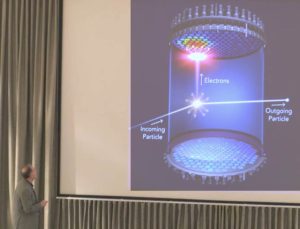 In this video, Tom Shutt from SLAC presents: Dark Matter – Detecting Gravity’s Hidden Hand.
In this video, Tom Shutt from SLAC presents: Dark Matter – Detecting Gravity’s Hidden Hand.
“Dark matter is one of the most mysterious components of the universe. Yet it makes up 23 percent of the mass of the universe – six times the mass of ordinary, atomic matter. Physicists have never observed dark matter particles directly, but we see their influence throughout astronomy. The gravitational pull of this hidden matter is the force that created structure in the universe, shaping galaxies and forming the distribution of clusters and voids we see in the sky. One of today’s great challenges in physics is to observe individual dark matter particles coming in from the galaxy and striking particles on Earth. This talk presents the evidence for dark matter and introduces one of the most ambitious efforts to discover interactions of dark matter particles, using tons of cryogenic liquid in a deep underground laboratory.”
SLAC Professor Tom Shutt has been searching for dark matter particles for most of his career. He received his PhD from UC Berkeley in 1993. In his graduate work there, he played a key role in developing low-temperature germanium detectors for dark matter searches. After terms as a research fellow at Berkeley and as an assistant professor at Princeton University, Shutt joined the faculty at Case Western Reserve University in 2005. At Case, he developed techniques for dark matter searches using detectors based on liquid xenon. He was co-founder of the LUX experiment, which is among the current world leaders in the search for the type of proposed dark matter particles called Weakly Interacting Massive Particles, or WIMPs. In 2014, Shutt and his collaborator Dan Akerib moved to SLAC to develop the truly large-scale liquid xenon WIMP detector LUX-ZEPLIN, or LZ.
In this related video, researchers at SLAC show a simulation of the 3-D distribution of dark matter. Its projection onto the sky corresponds to the 2-D map measured by DES.
Credit: Joe DeRose/Risa Wechsler/Ralf Kaehler/Stanford University/SLAC National Accelerator Laboratory




